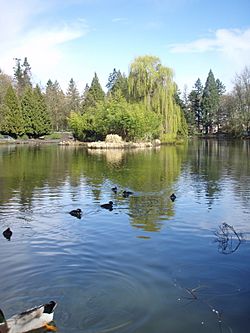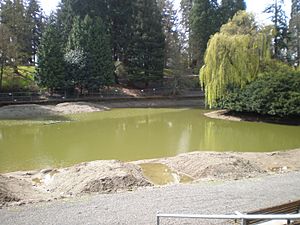Laurelhurst Park facts for kids
Quick facts for kids Laurelhurst Park |
|
|---|---|

Firwood Lake at Laurelhurst Park in March 2008
|
|
| Type | Urban park |
| Location | SE César E. Chávez Blvd. and Stark St. Portland, Oregon |
| Area | 26.81 acres (10.85 ha) |
| Operated by | Portland Parks & Recreation |
| Status | Open 5 a.m. to 10:30 p.m. daily |
| Built | 1909 |
| MPS | City Beautiful Movement and Civic Planning in Portland, Oregon MPS |
| NRHP reference No. | 01000134 |
| Added to NRHP | February 16, 2001 |
Laurelhurst Park is a wonderful city park located in the Laurelhurst neighborhood of Portland, Oregon. This park covers about 26.81 acres. It was first bought in 1909 from the family of William S. Ladd, who used to be the mayor of Portland.
The City of Portland officially bought the land in 1911. The next year, park superintendent Emanuel Mische designed the park. He followed a special plan called the Olmsted Plan. In 1919, the Pacific Coast Parks Association called Laurelhurst Park the "most beautiful park" on the West Coast. In February 2001, it became the first city park ever to be listed on the National Register of Historic Places. This means it's a very important historical site!
Park History
The land for Laurelhurst Park was bought in 1909. It came from the estate of William S. Ladd, who was a former mayor of Portland. He had developed another area called Ladd's Addition. This land was once part of a large farm owned by Ladd. It was known as one of the best stock farms in the West.
However, the land became too valuable for farming. So, the City of Portland bought it in 1911. They wanted to create a park following the Olmsted Plan. Emanuel Mische, who was Portland's park superintendent from 1908 to 1914, designed the park in 1912. He had a lot of experience as a gardening expert. He worked for the Olmsted Brothers, a famous landscape design company.
Mische designed the park to look natural. He created seven different areas. These included a concert grove, Firwood Lake, and a children's lawn. There was also a plateau, broad meadows, a picnic grove, and Rhododendron Hill. A pond, once used for cattle, was made deeper into a 3-acre lake. A "play park" was also set up. Boys played on one side, girls on another, and general games were held on the east side. A restroom building was built in 1914. The next year, paths and sidewalks were lit by electric lights.
Fun Things to Do
Laurelhurst Park has many features for everyone to enjoy. You can find a basketball court and a soccer field. There are also tennis courts and a volleyball court. Kids love the playground.
If you have a dog, there's a special off-leash area for them. You can also play horseshoes at the pit. The park has both paved and unpaved paths for walking or running. There are picnic sites with tables, perfect for a family meal. You can also find public art and a stage in the park. Restrooms are available for visitors.
Past Events
Laurelhurst Park has been the site of many special events over the years. The Portland Rose Festival Queen's Coronation used to happen in the park pond. The queens would be on floating boats and decorated rafts. This event would attract thousands of visitors!
During the 1930s, people from Junction City often held their yearly picnic at Laurelhurst. The park has hosted many other picnics and family reunions. In the 1950s, Easter Sunrise Services were held at the park. These services also brought thousands of people together.
Nature in the Park
Portland Parks & Recreation aims for about 10 male/female pairs of ducks in the park. But in 1987, the duck population was around 120. Sometimes, it even reached over 200, including ducks just passing through. All these ducks caused the water to become murky. Portland Parks & Recreation tried to reduce the duck population. They even had an "adopt-a-duck" program. But the ducks were too hard to catch!
In 1990, the lake had a problem with too many fish. Nearly 20,000 catfish, carp, and black crappie fish were stirring up the mud. This overcrowding also caused bad smells. A fishing club tried to reduce the fish population, but it didn't work.
By 2008, the lake was very unhealthy. It was acutely eutrophic, meaning it didn't have enough oxygen. The mud at the bottom had made the lake much shallower. It went from 13-15 feet deep to only 18 inches! Each year, a lot of blue-green algae grew because the shallow water heated up quickly. To fix this, Portland City Council provided money to dredge the lake. Dredging means removing mud from the bottom. They also installed a system to add air and circulate the water. This helped make the lake healthier.
Images for kids



